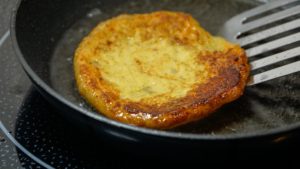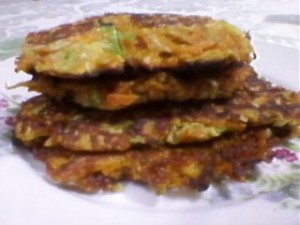Some oily (and other) tips and great latkas for Chanukah
Gastronomy is at least as important as ritual when it comes to the  holidays. We all enjoy the delicious latkas (vegetable pancakes) and sufganiyot (donuts) that are customary Chanukah fare. However, since we still want keep our waistlines and health in check, I have a few tips for you.
holidays. We all enjoy the delicious latkas (vegetable pancakes) and sufganiyot (donuts) that are customary Chanukah fare. However, since we still want keep our waistlines and health in check, I have a few tips for you.
♦ Cut back on the carbs. Carbohydrates are what really help to put on the pounds. Simply put, carbohydrates are starches, polysaccharides, made up of glucose (sugar) molecules. Carbohydrates break down into glucose in the digestive system; too much glucose released too quickly into the bloodstream causes an insulin rush as the pancreas tries to get the excess sugar out of your bloodstream. What cannot be immediately utilized for energy, gets stored as fat in your cells in the form of triglycerides.
So, rather than loading up on sufganiyot (have one or two whole grain ones if you must), you are better off enjoying latkas, non-potato latkas in particular, since potatoes are carbohydrates as well. Now I’m not going to tell you to avoid potato latkas entirely, I will have some too, but it would be good to have a combination of different types, if you are having them more than once during the holiday. If you do have potato latkas during a milichig/chalavi meal, choose sour cream over applesauce as an accompaniment. For a fleishig/besari meal you are probably already eating a meal with fat. Fats take longer to digest than carbohydrates, so by eating the two together, glucose is released into your bloodstream at a slower rate.
♦ Switch from polyunsaturated oils to healthier options. In general, there are three major problems with consuming polyunsaturated oils.
1) They are very high in omega-6 fatty acids (about 50%) and extremely low in omega-3 fatty acids (soy oil being an exception). To function properly, we need these polyunsaturated fatty acids in a ratio of 1.5% omega-3 to 2.5% omega-6.
2) Our intake of polyunsaturates should only be about 4% of our caloric intake; however, we are consuming as much as 30% of our calories as polyunsaturates.
3) Polyunsaturated oils become oxidized or rancid when subjected to heat forming free radicals which cause much damage in the body. Polyunsaturated oils which are not cold-pressed are subject to high heat and chemicals in order to extract the oil.
Canola oil is also not a healthy oil to use. Although it’s been marketed as one of the healthiest of all the vegetable oils because it has a better balance of omega 6 to omega-3 fatty acids, there are several problems with using it for food. Canola oil is really rapeseed oil which has been bred to reduce the amount of toxic erucic acid it contains to levels which are considered safe. Its high sulfur content causes it to go rancid very easily; the deodorizing process transforms the omega-3 fatty acids into trans fats; and there is evidence that canola oil creates a deficiency in vitamin E, as well. It is also a genetically modified crop.
The best, most stable, and healthiest oils to use when frying are olive oil, at moderate temperatures, peanut oil and sesame oil occasionally since they are stable when heated but high in omega 6 fatty acids, and palm oil and coconut oil which are not only very healthy but are also very stable when heated. Flax-seed oil which, because of its high omega-3 fatty acid content (a good remedy for the omega-6 to omega-3 imbalance most of us have), should not be heated and always kept in the refrigerator. It is best consumed in small amounts. Animal fats and butter are also good choices for cooking and frying.
 With the exception of flax-seed oil, all of the above contain medium to high percentages of saturated fats as well. Saturated fats are very necessary as they fill many roles in the body. They are critical to maintaining the stiffness and integrity of our cell walls, are needed to incorporate calcium into our bones, help us properly utilize omega-3 fatty acids, protect the liver from toxins, and more. Our over-consumption of polyunsaturated oils and their inherent imbalance of omega-6 to omega-3 fatty acids unfavorably alters our biochemistry, leaving us prone to disease and illness.
With the exception of flax-seed oil, all of the above contain medium to high percentages of saturated fats as well. Saturated fats are very necessary as they fill many roles in the body. They are critical to maintaining the stiffness and integrity of our cell walls, are needed to incorporate calcium into our bones, help us properly utilize omega-3 fatty acids, protect the liver from toxins, and more. Our over-consumption of polyunsaturated oils and their inherent imbalance of omega-6 to omega-3 fatty acids unfavorably alters our biochemistry, leaving us prone to disease and illness.
♦ Heat up the pan very well before frying to cut back on the amount of oil needed. I noticed several years back that the pancakes that I fried last came off the pan more easily than the ones I did first. The only difference between the earlier and later batches was how hot the pan was, having had the opportunity to heat up more while I was frying. So I started making sure that the pan is well heated before I start. When it’s ready I pour a little oil in (probably about a tablespoon for a 10 inch pan) , spread it around, and then drop in my batter by spoonfuls. If it needs to be scraped off the pan, leave it alone. It is not ready. Flip the latka or take it out of the pan when it feels firm enough to lift off with a spatula. I do add more olive oil when necessary, but in really small amounts. Olive oil is rich in antioxidants and, besides coconut oil, is the safest vegetable oil to use when cooking.
 I made two zucchini latka recipes. The first one, a takeoff on the Mashed Zucchini Salad recipe from The Book of Jewish Food, by Claudia Roden, used zucchini, onion, salt, lemon juice, and coriander. It was good; we all enjoyed it. However, the second one I made, Sweet Potato and Zucchini Latkas was a real winner. Yes, sweet potato is a carbohydrate too, but by adding the zucchini, it becomes a lower carbohydrate option.
I made two zucchini latka recipes. The first one, a takeoff on the Mashed Zucchini Salad recipe from The Book of Jewish Food, by Claudia Roden, used zucchini, onion, salt, lemon juice, and coriander. It was good; we all enjoyed it. However, the second one I made, Sweet Potato and Zucchini Latkas was a real winner. Yes, sweet potato is a carbohydrate too, but by adding the zucchini, it becomes a lower carbohydrate option.
Ingredients:
- 2 cups grated zucchini
- 2 cups peeled and grated sweet potato
- 1 tablespoon extra-virgin organic olive oil to start, adding as necessary
- 1/4 cup finely diced yellow onion
- 1 garlic clove, minced
- 1 teaspoon salt
- 2 medium eggs (that’s the size I had in the house)
- 1/3 cup spelt flour
- 1/2 teaspoon baking powder
I used a hand-held grater. It was pretty quick and easy with less mess and easier clean up than if I had used the food processor. If you are making a larger batch, however, the food processor is quicker. Mix the zucchini and sweet potato together with the salt, put into a colander and let drain. The salt removes the excess liquid so the latkas are not wet. I actually put in all the salt at this point and did not add any more afterwards. After about half an hour I pressed out any remaining liquid, mix in the other ingredients, and dropped by spoonful into the frying pan, tapping them down so they are wider with more surface area being directly heated.
Of course these can be made without the flour and baking powder. They will probably not hold together as well, but the taste should still be great.
Chag Chanukah sameach.
Related Articles:
Choosing Healthy Fats and Oils: What you need to know
What You Need to Know Before Buying Your Next Bottle of Olive Oil, Olive Oil Fraud, and Israeli Olive Oils
Here’s Why Using Coconut Oil Regularly Contributes to Your Health
The Skinny on Fats
fantastic article , however canola is aproblem.https://draxe.com/canola-oil-gm/
Thanks. I’m glad you liked it. I did explain Canola oil’s health issues in the paragraph about Canola oil but I will reword it slightly so it will be more obvious.